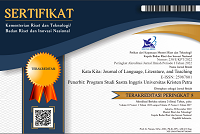Understanding the Function of Emojis in TikTok Comments for Prabowo Subianto
DOI:
https://doi.org/10.9744/katakita.12.2.154-159Abstract
This study examined the use of emoji in TikTok comments about Prabowo Subianto from the first presidential debate. This study applied Yus’ (2014) framework which identifies eight distinct emoji functions. Conducted through a qualitative analysis of 50 comments collected on the day of the video’s release, the findings indicated that emoji used performed all functions except for the illocutionary force modifier. The emoji used suggest vibrant and expressive interactions, where the TikTok users reacted both light-heartedly and critically. The absence of illocutionary force modifiers aligns with Prabowo Subianto's direct communication style, which prompts more straightforward responses from the TikTok users.References
Dictionary.com (2024) Emoji Retrieved April 12, 2024. https://www.dictionary.com/e/emoji/.com.
Ordway, D.-M., & Wihbey, J. (2016, September 20). Presidential debates and their effects: Research roundup. The Journalist’s Resource. https://journalistsresource.org/politics-and-government/presidential-debates-effects-research-roundup/
Yus, F. (2014). Not all emoticons are created equal. Linguagem Em, 14(3), 511–529. https://doi.org/10.1590/1982-4017-140304-0414
Downloads
Published
Issue
Section
License
Authors who publish with this journal agree to the following terms:- Authors retain copyright and grant the journal right of first publication with the work simultaneously licensed under a Creative Commons Attribution License that allows others to share the work with an acknowledgement of the work's authorship and initial publication in this journal.
- Authors are able to enter into separate, additional contractual arrangements for the non-exclusive distribution of the journal's published version of the work (e.g., post it to an institutional repository or publish it in a book), with an acknowledgement of its initial publication in this journal.
- Authors are permitted and encouraged to post their work online (e.g., in institutional repositories or on their website) prior to and during the submission process, as it can lead to productive exchanges, as well as earlier and greater citation of published work (See The Effect of Open Access).














